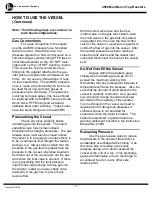
- 10 -
4560 Mini Bench Top Reactors
Parr Instrument Company
Revision 6-28-02
HOW TO USE THE VESSEL
Removable Head Vessel
Flat Gasket Closure
Always remove vessels from the
support stand before attempting to open or
close them.
To Open the Vessel
Open the gas release valve to
discharge any internal pressure; then loosen
the six cap screws in the split ring sections.
Loosen the cone pointed screw in the outer
band and lower the band to rest on the
table. The ring sections can now be
removed, and the head with all attached
fittings is free to be lifted from the cylinder.
Handle the head carefully so as not to
damage the stirring shaft and other internals
when they are outside of the cylinder.
Before Closing the Vessel
Examine the head gasket carefully to
be sure that it is in good condition. After
considerable use the PTFE gaskets may
extrude a thin, ragged edge around the
inside and outside diameters. This does not
necessarily mean that the gasket must be
replaced, but the extruded portion should be
removed with a sharp knife. Examine the
mating surfaces on the cylinder and the
head to be sure they are clean and free from
burrs then set the head on the cylinder.
To Close the Vessel
Slide the two ring sections into place
and position them so that the shallow socket
drilled in the outer surface of one of the ring
sections is 180
!
from the gage face. Raise
the outer band into place around the ring
sections and position the band so that the
cone pointed screw enters the socket
described above; then tighten the screw
lightly to hold the band in place.
Fixed Head Vessels
Fixed head vessels are opened and
closed with the same procedure used for
removable vessels except that they are
opened and closed with the head in place.
Before opening the vessel lower the heater
and swing it well to the side so that it will not
be damaged by any materials that drip from
the vessel as it is opened. When closing the
vessel always hold the cylinder until both
split ring sections and the drop band are in
place to lock the cylinder to the head.
Sealing Vessels with PTFE Gaskets
Tighten each of the cap screws with
the wrench furnished with the apparatus.
Apply a firm but hard pull to each screw. If a
torque wrench is available, apply 25 ft-lbs to
each screw. Tightening should proceed in a
criss-cross pattern rather than progressively
around the circle. Let the vessel stand for
about five minutes after the initial tightening;
then tighten the cap screws again. This will
compensate for any tendency of the PTFE
gasket to flow under the loading pressure.
Routinely inspect cap screws on split
ring closure for lubrication and cleanliness.
It is important to lubricate periodically so that
the required torque is achieved when
tightening the bolts.
O-Ring Closures
The split rings used with the self
sealing O-ring do not include the six cap
screws used to seal the flat gaskets. The O-
ring is held in a groove on the underside of
the head. Before closing the vessel
examine this O-ring carefully to see that it is
in good condition. Slide the head and
cylinder together until the top of the cylinder
and the bottom of the head come together.
Now install the two split ring sections and
lock them together with the drop band.










































